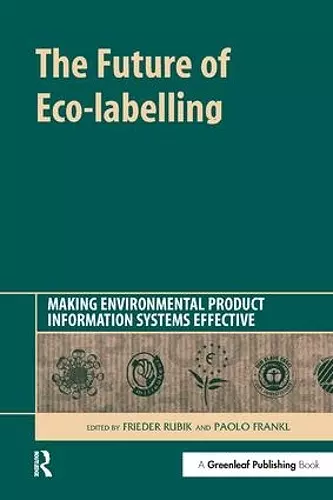The Future of Eco-labelling
Making Environmental Product Information Systems Effective
Frieder Rubik author Paolo Frankl author
Format:Hardback
Publisher:Taylor & Francis Ltd
Published:1st May '05
Currently unavailable, and unfortunately no date known when it will be back

Based on a major EU research exercise, this book plots a course for policy-makers to address some of the historic problems with eco-labelling, to learn what works and what doesn't and to move forward with schemes that can make a real difference to sustainable production and consumption. "a definite must-read for anybody involved in greening of products and services." Gallon Environment Letter
This book plots a course for policy-makers to address some of the historic problems with eco-labelling, to learn what works and what doesn't and to move forward with integrated schemes that can make a real difference to sustainable production and consumption.
Eco-labelling is one of the key tools used by policy-makers in many parts of the world to encourage more sustainable production and consumption. By providing environmental information on products and services, eco-labels address both business users and consumers and range from mandatory approaches, such as required product declarations, to voluntary approaches, such as national eco-labels.
Eco-labels can play an important role in environmental policy. They reward and promote environmentally superior goods and services and offer information on quality and performance with respect to issues such as health and energy consumption. Eco-labels fit well into a multi-stakeholder policy framework – as promulgated recently by the EU's integrated product policy (IPP) – since the development of criteria for labels and the acceptance in the market requires the involvement of a wide range of different parties, from government and business, to consumers and environmental organisations.
However, many eco-labelling schemes have had troubled histories, and questions have been raised about their effectiveness. So, are eco-labels an effective tool to foster the development, production, sale and use of products and to provide consumers with good information about the environmental impacts of those products? Is eco-labelling useful to business as a marketing tool? What factors contribute to the development of successful schemes? More than ten years after its establishment, can the EU Flower be considered a success? Are national eco-labels such as the German Blue Angel and the Norwegian White Swan more effective? Should eco-labels be harmonised? Are eco-labels achieving their original aim of fostering sustainable production and consumption? For which product groups are ISO type I eco-labels appropriate and inappropriate? Are other labels, such as mandatory, ISO type II and ISO type III labels more effective in some cases? Are eco-labels focusing on the main environmental policy targets or just on "low-hanging fruit"? Are eco-labels really linked to other tools of IPP?
The Future of Eco-labelling provides answers to all of these questions. Based on a major EU research exercise, the book plots a course for policy-makers to address some of the historic...
Used properly, eco-labels, or environmental product information schemes, play an important part in environmental policy, the authors argue. With the help of case studies (from washing machines to tourism) they formulate scientifically based recommendations for policy-makers and stakeholders alike. What makes an effective eco-labelling scheme? For which product groups are ISO labels appropriate or inappropriate? Based on a major EU research project, The Future of Eco-labelling provides some thoughtful answers. - Corporate Citizenship Briefing, September 2005 - Oliver Wagg
A definite must-read for anybody involved in greening of products and services. - Gallon Environment Letter Vol. 10 No. 11 (20 June 2005)
ISBN: 9781874719878
Dimensions: unknown
Weight: 453g
357 pages